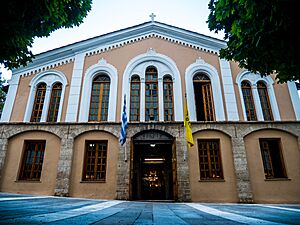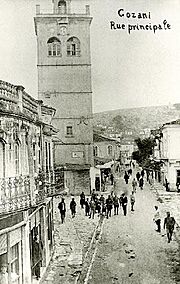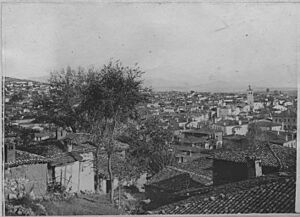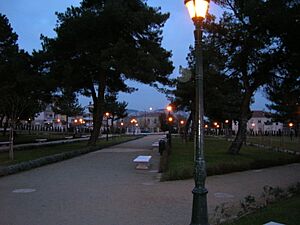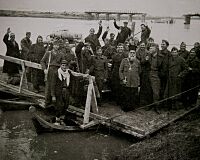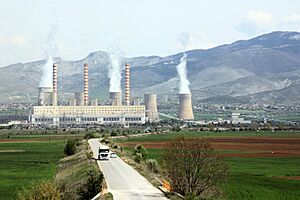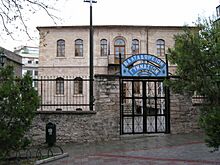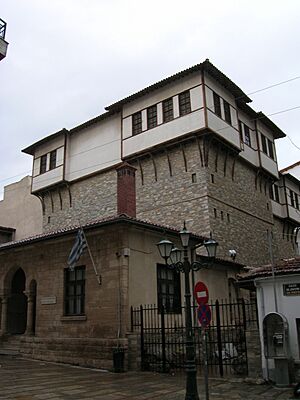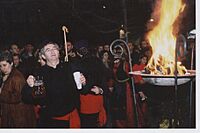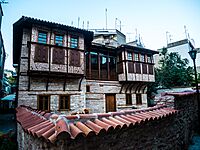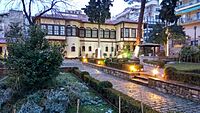Kozani facts for kids
Quick facts for kids
Kozani
Κοζάνη
|
|
|---|---|
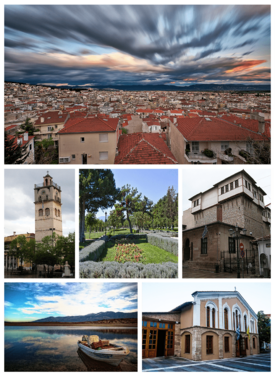 Clockwise from top: Panoramic view of the city of Kozani, Municipal Garden of Kozani, Historical–Folklore and Natural History Museum of Kozani, Church of Saint Nicholas, View of the nearby Lake Polifytos, Nikis Square and its Clock Tower.
|
|
| Country | Greece |
| Geographic region | Macedonia |
| Administrative region | Western Macedonia |
| Regional unit | Kozani |
| Districts | 20 |
| Area | |
| • Municipality | 1,071.3 km2 (413.6 sq mi) |
| • Municipal unit | 366.0 km2 (141.3 sq mi) |
| Elevation | 710 m (2,330 ft) |
| Population
(2021)
|
|
| • Municipality | 67,224 |
| • Municipality density | 62.750/km2 (162.522/sq mi) |
| • Municipal unit | 53,174 |
| • Municipal unit density | 145.284/km2 (376.28/sq mi) |
| Community | |
| • Population | 43,316 (2021) |
| • Area (km2) | 34.371 |
| Time zone | UTC+2 (EET) |
| • Summer (DST) | UTC+3 (EEST) |
| Postal code |
501 xx
|
| Area code(s) | 2461 |
| Vehicle registration | KZ, MN |
Kozani (Greek: Κοζάνη) is a city in northern Greece. It is the capital of the Kozani regional unit and the region of Western Macedonia. The city is located in the western part of Macedonia. It sits in the northern part of the Aliakmonas river valley.
Kozani is about 710 meters (2,330 feet) above sea level. It is 15 kilometers (9 miles) northwest of the artificial lake Polyfytos. The city is surrounded by mountains like Pieria, Vermio, Vourinos, and Askio. Over 67,000 people live in the Kozani municipality. The weather here has cold, dry winters and hot summers.
Kozani is home to the University of Western Macedonia. Around 15,000 students from all over Greece study here. It is also an important center for government services. These include the court of appeal, police, and fire brigade for West Macedonia. The city is also known for its lively carnival celebrations. These events happen at the end of winter. Kozani is also famous for producing saffron (Krokos Kozanis). This special spice comes from the nearby town of Krokos.
Kozani is a key travel hub. It connects Central Macedonia, Thessaly, and Epirus. The nearest airport is Filippos Airport. It is only 4 kilometers (2.5 miles) from the city. Kozani is also close to the A2 motorway. This highway links the Ionian Sea coast with Thessaloniki and the Turkish borders.
Contents
- What Does the Name Kozani Mean?
- A Look Back in Time: Kozani's History
- How Kozani Makes Money
- Cool Places to Visit in Kozani
- News and Media in Kozani
- Getting Around Kozani
- Kozani's Weather
- Learning in Kozani: Schools and University
- Kozani's Culture and Traditions
- Kozani's International Friends
- Images for kids
- See also
What Does the Name Kozani Mean?
Many people believe the name Kozani comes from a village in Epirus called Kósdiani. Settlers from this village founded Kozani in 1392. The settlement was first called Kózdiani. Over time, its name changed to Kóziani, and finally to Kozáni.
A Look Back in Time: Kozani's History
Ancient Times
Archaeologists have found many old items in Kozani. These discoveries range from prehistoric times to the Byzantine era. An ancient burial ground from the early Iron Age was found in eastern Kozani. During the time of Philip II of Macedon, this area was called Elimeia. It was part of Upper Macedonia. There might have been a town named Tyrissa here. To the southwest of the modern city, on Siopoto hill, there was a settlement called Kalyvia. It existed between 1100 and 1300. You can still see traces of it today.
Kozani During the Ottoman Empire
Kozani was likely founded by Christian settlers. They moved to the mountains after the Ottoman conquest. This happened during the 14th and 15th centuries. Its safe location soon attracted other Christians. Many of them were expelled from Epirus in 1392. Along with these settlers, many cattle-breeders also moved to the area.
The first official record of Kozani is from 1528. An Ottoman register shows it as a settlement with 91 houses. In 1530, it was recorded as a village named Kozani. It was part of the Serfice region. A key person in Kozani's early growth was Ioannis Trantas. He was a chief shepherd who brought about 100 families to settle there. His son, Charisios Trantas, got a special order from the Sultan in 1664. This order placed the town under the protection of the Sultan's mother. It gave Kozani many special rights. It also made it forbidden for Turks to settle in the town.
In 1664, the beautiful church of Agios Nikolaos (St. Nicholas Cathedral) was built. The library and a famous school were founded in 1668. During the 17th and 18th centuries, trade with countries in central Europe helped the city's economy grow. By the 19th century, Kozani's population was growing. Most of its people were Greek.
The city's growth was interrupted in 1770. This happened because of conflicts between local people and Kozanite merchants. The city was also attacked by Turkish leaders in 1770. Another attack in 1830 caused even more damage. In 1855, a 26-meter (85-foot) tall bell tower was built next to St. Nicholas Church. This tower became a symbol of the city. In 1939, a clock was added to the top. It was a gift from Konstantinos Mamatsios, a Greek-American.
Kozani During the Balkan Wars
The Greek army entered Kozani on October 11, 1912. This happened during the First Balkan War. It followed their victory against the Ottoman army in the Battle of Sarantaporo. At this time, Kozani had about 12,000 Orthodox Greeks. In 1923, many Greek families from Pontus and Asia Minor moved to Kozani. This was part of a large population exchange between Greece and Turkey.
Kozani in Modern Times
In the 20th century, Kozani grew a lot. This was because of the large amounts of lignite (a type of coal) found nearby. The Public Power Corporation started using these reserves. This made Kozani the top producer of electricity in Greece. An earthquake hit the region on May 13, 1995. It had a magnitude of 6.6 on the Richter scale. Luckily, it only caused damage to buildings, not many injuries.
Today, Kozani mixes modern and old architecture. Important buildings include the clock tower and the town hall. The folklore museum is also notable. The "Valtadoreio" Gymnasium and the National Bank of Greece building are also beautiful. The mansions of Georgios Lassanis and Grigorios Vourkas are also worth seeing.
The Municipal Library of Kozani, called "Kovendareios," is the second largest in Greece. It has 150,000 books and rare documents. It even has one of the few copies of Rigas Feraios' charter. Because of this, Kozani is known as the City of Books. It is also the main center for business and transport in West Macedonia.
How Kozani Makes Money
Kozani is best known for its role in Greece's electricity supply. Many people in the city work for the Public Power Corporation. They work at the lignite-fired Agios Dimitrios Power Plant. This is the largest power plant in Greece. The Ptolemaida Basin area produces 40% of the country's electricity.
Other important products from Kozani include marble and saffron. Local fruits and wines are also well-known. The city also has a special arts and crafts industry. The Commercial Exhibition of Kozani happens every September. It takes place at the Exhibition Centre of Western Macedonia. Many businesses from Greece and other Balkan countries attend. They often show off local products.
Cool Places to Visit in Kozani
Downtown Attractions
- The Archaeological Museum of Kozani: Here you can see ancient artifacts found in the area.
- The Historical–Folklore and Natural History Museum of Kozani: This museum shows old Macedonian architecture. It has six floors. Visitors can learn about the region's geography, nature, plants, and animals. It also shows Kozani's history, traditions, and how people used to live.
- The Museum of Modern Local History of Kozani: This museum focuses on more recent local history.
- The clock tower and the church of Agios Nikolaos: This church is 350 years old. Both are located in Nikis Square.
- Other interesting places include the Grigorios Vourkas Mansion and the Georgios Lassanis Mansion. The Lassanis Mansion is in Lassani Square. It is now used as the Municipal Map Library.
Nearby Attractions
- The Municipal Park Kouri: This park is in Agios Dimitrios. Here you can find the Cultural Center and the Municipal Theatre of Kozani. The Xenia hill in the park offers a great view of the whole city.
- The Museum of the Macedonian Struggle in Chromio: This museum tells the story of the Macedonian Struggle.
- Polyphytos bridge: This bridge crosses the artificial Polyphytos lake. It is 1,372 meters (4,501 feet) long. It is the second longest bridge in Greece.
News and Media in Kozani
Kozani has several TV and radio stations. These include West Channel, TOP Channel, and Flash TV. Popular newspapers are Chronos, Grammi, and Tharros. There are also magazines and online news sites based in Kozani.
Getting Around Kozani
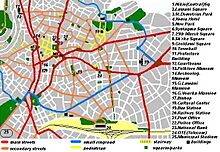
You can reach Kozani by car using the A2 motorway (E90). This road connects it to Ioannina and Thessaloniki. Other main roads like GR-3 (or E65) also lead to Kozani.
- By Bus: You can take a bus from Kozani to all towns in West Macedonia. There are also buses to major Greek cities. These include Athens (4 times a day, 470 km away) and Thessaloniki (every hour, 120 km away).
- By Plane: Sky Express connects Kozani with Athens and Kastoria. Flights use Filippos Airport. The airport is about 3 km (1.9 miles) southeast of Kozani.
Within the city, minibuses provide public transport. Larger Transit buses connect the city center with its different areas. Traffic in Kozani has become busier in recent years.
Kozani's Weather
Kozani has a humid subtropical climate. This means summers are warm to hot. Winters can be cold with snow, but heavy snowfalls are rare. Rain falls fairly evenly throughout the year. The highest temperature ever recorded was 41.2°C (106.2°F) on July 25, 2023. The lowest was -15.0°C (5.0°F) on January 8, 2017.
| Climate data for Kozani (1955–2010) normals | |||||||||||||
|---|---|---|---|---|---|---|---|---|---|---|---|---|---|
| Month | Jan | Feb | Mar | Apr | May | Jun | Jul | Aug | Sep | Oct | Nov | Dec | Year |
| Mean daily maximum °C (°F) | 6.2 (43.2) |
8.2 (46.8) |
11.8 (53.2) |
16.5 (61.7) |
21.9 (71.4) |
26.8 (80.2) |
29.6 (85.3) |
29.6 (85.3) |
24.9 (76.8) |
18.8 (65.8) |
12.5 (54.5) |
7.5 (45.5) |
17.9 (64.2) |
| Daily mean °C (°F) | 2.3 (36.1) |
3.8 (38.8) |
7.2 (45.0) |
11.8 (53.2) |
17.1 (62.8) |
21.8 (71.2) |
24.5 (76.1) |
24.0 (75.2) |
19.3 (66.7) |
13.7 (56.7) |
8.1 (46.6) |
3.8 (38.8) |
13.1 (55.6) |
| Mean daily minimum °C (°F) | −1.2 (29.8) |
−0.4 (31.3) |
2.1 (35.8) |
5.6 (42.1) |
10.0 (50.0) |
13.7 (56.7) |
16.3 (61.3) |
16.3 (61.3) |
12.7 (54.9) |
8.4 (47.1) |
3.9 (39.0) |
0.3 (32.5) |
7.3 (45.1) |
| Average rainfall mm (inches) | 34.7 (1.37) |
31.1 (1.22) |
36.4 (1.43) |
42.3 (1.67) |
54.7 (2.15) |
36.6 (1.44) |
33.4 (1.31) |
27.8 (1.09) |
34.1 (1.34) |
49.7 (1.96) |
56.1 (2.21) |
53.4 (2.10) |
490.3 (19.29) |
| Average rainy days | 10.2 | 9.4 | 10.6 | 10.4 | 11.4 | 7.8 | 5.6 | 5.1 | 6.7 | 8.2 | 10.2 | 11.8 | 107.4 |
| Average relative humidity (%) | 75.5 | 70.9 | 66.8 | 63.2 | 62.4 | 54.9 | 49.6 | 50.7 | 58.2 | 67.9 | 75.4 | 77.2 | 64.4 |
| Source: Hellenic National Meteorological Service | |||||||||||||
Learning in Kozani: Schools and University
Kozani has many schools for different ages. There are 18 Primary schools in the main city. Eight more are in nearby towns like Vatero and Kariditsa. The city has 8 Gymnasiums (middle schools). Two more are in Lefkopigi and Xirolimni. There are also 4 high schools (Lyceums) and 4 Vocational Schools (EPAL). Kozani also has some Business Schools and a municipal music school called an Odeum.
The city is home to the University of Western Macedonia. This university has 7 Faculties and 22 Departments. These are spread across 5 cities: Kozani, Florina, Kastoria, Ptolemaida, and Grevena. The main campus is in Kozani. The university was founded in 2002.
Kozani's Culture and Traditions
Festivals and Events
Kozani Carnival is one of the most important events in the region. It happens at the end of winter. The exact dates change each year, depending on when Lent begins. Carnival celebrations in Kozani, and all over Greece, last for eleven days. They start on Τσικνοπέμπτη (Tsiknopempti), which means "Charred Thursday." This is similar to Mardi Gras. The celebrations end on Καθαρά Δευτέρα (Kathara Deftera), or "Clean Monday," which is like Ash Wednesday.
During the Kozani carnival, big bonfires are lit in different parts of the city. Each night, a different area lights its fire. People dance around the fire. On the last night of the carnival, all the fires are lit at once. These festive fires and the groups that organize them are called Fanoi (fires). Each fanos welcomes visitors with songs and dances. They offer local treats like kichia (cheese pie) and meatballs, along with wine. People sing popular songs and dance around the fire. At midnight, funny and sometimes rude songs are sung. Bands also play instrumental songs, like the Enteka. This song is often called Kozani's "national anthem." All these celebrations happen in the local Kozani Greek dialect.
In 2010, Theodoros Lakkas published the first collection of Kozani's carnival songs. He was a lead singer of the fanos Lakkos t' maggan. His book is called Ivgati Agoria m stou chouro (Go dance, my boys).
At the end of summer, Lassaneia Events are held. These include plays, concerts, and sports events. The name "Lassaneia" comes from Georgios Lassanis. He was from Kozani and fought in the Greek War of Independence. A part of these events is also a song festival for new artists.
Niaimeros is a fair held in northern Kozani. It takes place on the first Tuesday of October. It used to last nine days (niaimeros means "nine days"). Now, it only lasts for three days.
Official local holidays include the celebration of the city's liberation from the Turks on October 11. Also, Saint Nicholas day on December 6 is celebrated. Saint Nicholas is Kozani's patron saint.
The city's municipal Band is called Pandora. It was founded in 1902. The band plays at all city events and celebrations.
What to Eat in Kozani
A traditional dish in Kozani is called Yaprákia. It is made with meat and rice wrapped in salty cabbage leaves. They are shaped like an egg. This dish is often eaten at Christmas. Kichí (Kozanitiko kichí) is another local food. It is a cheese pie shaped like a circular snail.
Famous People from Kozani
Many notable people have come from Kozani. Here are a few:
- Ioannis Amanatidis (born 1981), a footballer.
- Nikolas Asimos (1949–1988), a composer and singer.
- Anna Diamantopoulou (born 1959), a politician and former EU Commissioner.
- Georgios Lassanis (1793–1870), a scholar and politician.
- Giorgos Papakonstantinou (born 1961), an economist and former Minister for Finance.
- Michalis Papakonstantinou (1919–2010), a lawyer and former Minister for Foreign Affairs.
- Ieroklis Stoltidis (born 1975), a footballer.
- Apostolos Telikostoglou (born 1995), a taekwondo athlete.
Sports in Kozani
- Kozani FC is a local football team. They play in the Greek Third Division.
Kozani's International Friends
Kozani has special partnerships with other cities around the world. These are called twin towns or sister cities.
 Bristol, Connecticut, USA (since 1987)
Bristol, Connecticut, USA (since 1987) Iaşi, Romania
Iaşi, Romania Toluca, Mexico
Toluca, Mexico Turgovishte, Bulgaria (since 2002)
Turgovishte, Bulgaria (since 2002)
Images for kids
See also
 In Spanish: Kozani para niños
In Spanish: Kozani para niños




